
views
Learning More About Betta Fish

Do some initial background research. There is a lot to know about betta fish, even beyond the basics just outlined. In general, large box stores aren't in the business of providing detailed information, unless you happen to strike a betta enthusiast salesperson. As well as having the basic understanding of betta outlined above, you might consider researching more details about betta fish online at specialist sites. These sites will remain useful for you after purchase too, as you'll be able to ask questions, check up health and nutrition notes and find like-minded betta fans to share stories with.
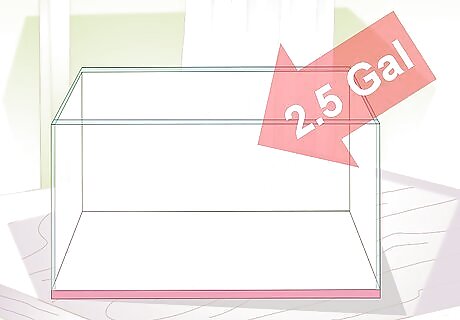
Understand the care requirements. Please be aware of what you are getting into before you buy a betta fish. Know that these fish can live up to five years under the proper care, so do your research before buying. The absolute minimum size tank for a betta fish is 2.5 gallons with a heater and filter, although if you have a bigger tank, you don't have to do as many water changes. Despite the recent fad of keeping bettas in small vases or bowls please do not keep a betta fish in a tank or bowl that holds less than 2 gallons; it is terrible for their health and is very small! Remember that even though these fish may look like flowery decorations, they are live animals that need room to swim around and space on the surface of the water to breathe and eat. Your betta fish will not be happy or live as long if kept in these small places. Think of it like this, you could survive in a small box if given food and water right? But you wouldn't be very happy!
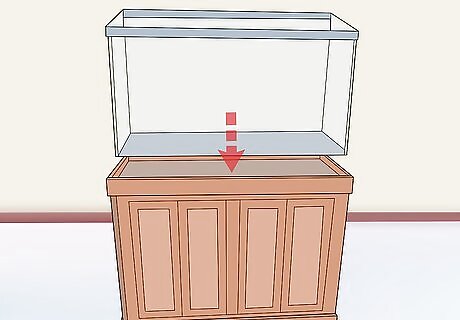
Understand the proper environment for a betta. The best room for a betta tank is one that is calm, quiet, and off-limits to pets that are a risk to bettas, such as dogs or cats. The tank should be placed on a sturdy, level surface to prevent the tank from spilling over, and there should be outlets nearby to plug the heaters and filters into. The tank should be away from things like windows, vents, doors, or humidifiers, as the temperature fluctuations and UV exposure can pose a danger to the health of your betta, and encourage harmful algae growth in your tank.
Preparing Housing for the Betta
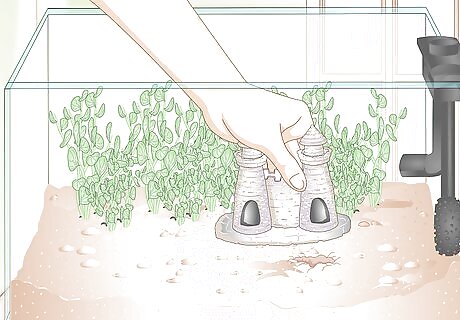
Prepare your betta's home. Have a proper set up ready before bringing home your new pet. This prevents possible mishaps. Lots of people skip this step, but it might be a good idea, if you find a fish, to ask a store employee to put it in the back or tuck it out of sight so you can come back for it a few days later. It's also advisable to cycle your tank at least a month beforehand, especially if you have live plants in your tank. Don't place a male betta fish with another male, and don't place a female with a female. Contrary to popular belief, placing girls together, called sororities, are not at all safe and in fact very dangerous and stressful for the fish involved. If you want two bettas, don't put them together under any circumstances unless a specific setup of around 50 gallons. This setup will give both Bettas enough space for territory. They have been selectively bred to have an instinct to fight another individual of their species to death, hence getting the name Siamese fighting fish. Female betta fish will fight males and vice versa. Don't put them in together. Read up on breeding them if you think you want to try it, but remember that breeding bettas is a huge commitment, and not something to be taken lightly.
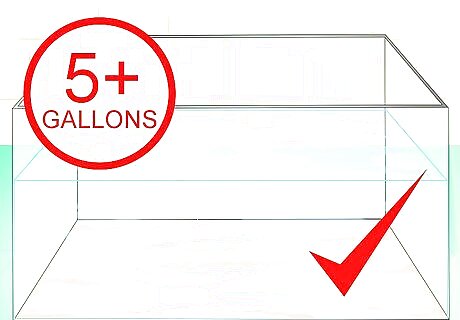
Choose a suitable home. In the wild, bettas inhabit Thai rice paddies. Hence, they are suited to living in relatively shallow, but very large environments. To meet the spacious need, consider giving your betta a decently sized tank. This will help prolong its life. Pick a tank of 5 gallons (19 liters) or more for your betta to thrive. It may seem like a lot, but it's what your fish deserves.
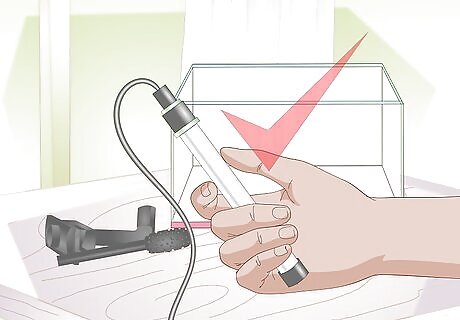
Add the necessary equipment. Various equipment is required for the successful keeping of Betta fish: Purchase a heater with a thermostat––Betta fish like water temperatures between 78-82ºF/24-27ºC. Bettas need a heater in all cases (they are tropical fish) ––for example, if you live in a cold country or if you have an aquarium below room temperature, then a heater is required. During the winter, you may want to add another heater or place your aquarium close to a radiator (1 meter/3.2 feet away), to prevent your betta from becoming too cold. Filters are always necessary but make sure the current is not too strong for your betta. Bear in mind that the long-finned varieties do best with as little current as possible, while still having filtration. Some experts recommend the use of sponge filters, to protect the fins. Avoid jagged rocks or decorations. Such decorations can easily tear sensitive betta fins. It's recommended that you check once a day that there are no tears in the betta's fins. If there are tears, first check the water quality, as fin rot, often mistaken for tearing, are typically caused by poor water maintenance. Avoid adding any hard-plastic plants. Again, these can be rough on the fins. Use the 'pantyhose test': If a plastic plant will snag a pair of pantyhose when rubbed against it, then it will damage your betta's fins. Be safe and buy silk plants or live plants instead. Live plants are a great idea. They give a more natural look to your tank than fake ones, and betta fish love lounging on the leaves and hiding in them to sleep. Live plants also help to oxygenate the water and keep the water cleaner for longer periods of time by absorbing nitrates, which can be harmful to your fish.
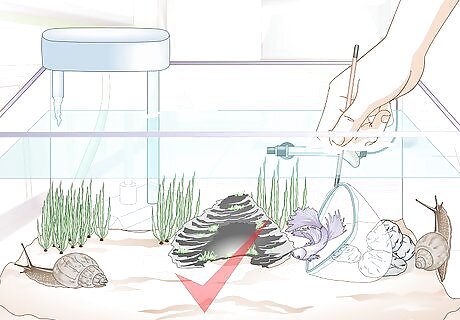
Do research if you are considering adding tank-mates. Betta fish tend to prefer being alone and may kill other fish and even invertebrates if added to the tank. Some calm-tempered fish can coexist with peaceful bottom dwellers like snails or corydoras. Shrimp tend to not be suitable tank-mates because bettas see them as food, and fish with bright colors and long tails can be bullied by your betta. Before adding any sort of tank-mate, do thorough research on both bettas and the other species to make sure the water parameters and size of your tank are suitable for both species. The article Buy Fish for an Aggressive Freshwater Aquarium can assist with choosing a tank-mate for your betta. If in doubt, leave the tank-mate out.
Adding Water to the Tank
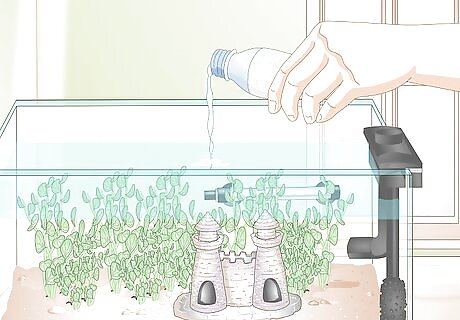
Prepare the water. Use a quality water conditioner such as Seachem Prime before putting fresh tap water in the tank. The chlorine and chloramines in standard tap water can harm bettas, as well as kill off all that beneficial bacteria housed in the filter. Older sources may suggest aging the water (standing it for a time) but it's best to use a water conditioner, as aged water removes chlorine but not chloramine and heavy metals. Use a master freshwater test kit to ensure that your tank is completely cycled before adding your betta! The parameters should be: ammonia 0 ppm, nitrite 0ppm, nitrate <20 ppm, and around 7 pH. It is a not a good idea to use distilled bottled water because this deprives your betta of necessary minerals and is not fish 'safe'. Treated tap water is both a cheaper and better alternative.
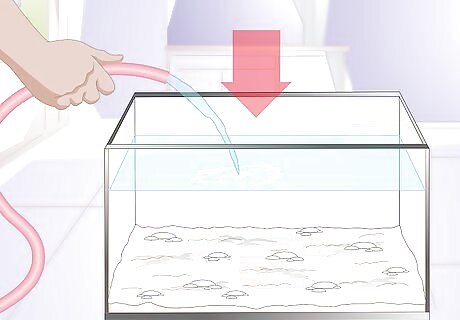
Fill the betta's tank. If the tank is without a top cover, fill it about 80% high to ensure your fish won't leap out. Bettas are very active and can jump over 3 inches/7.5cm when motivated! However, bettas usually won't be trying to escape if they're comfortable in their home.
Buying the Betta and Adding it to the New Home

Pick your betta fish. Here are some things to look for. Look at the color. Is the betta's color bright and vivid, or is it very dull? Even if the betta's color is a little pale, it should shine nicely. Bettas come in a variety of colors, but blues and reds (dark colors in general) are most common, although sometimes they can be white with a pink or blue tint. Does the betta respond to your movement at all? Does it swim around rapidly when seeing you, or does it merely sit at the bottom and sulk? Don't repeatedly tap the container, as doing so agitates the fish. Instead, try moving your finger back and forth in front of the Betta without aggravating it. Don't be afraid to buy a somewhat docile betta though; they generally have many encounters with other people during their day, and may simply be resting. The average betta bought in a pet store has been bred to withstand a lot of the hassles of a pet's lifestyle. Are its fins in good condition, or are they torn or otherwise damaged? Keep in mind that some breeds have intricate fins, so they might look slightly torn. Crowntails are one variety that naturally appear to be torn, so watch out. Are the betta's eyes in good shape? Do you see any odd lumps (parasites) on its body? If you see anything highly out of the ordinary, consider another betta. (it would also be helpful to talk to a store employee) Sometimes, the fish will choose you, not the other way around. If there is one betta that you are drawn back to it repeatedly, unless it is sick or unhealthy, consider buying it.
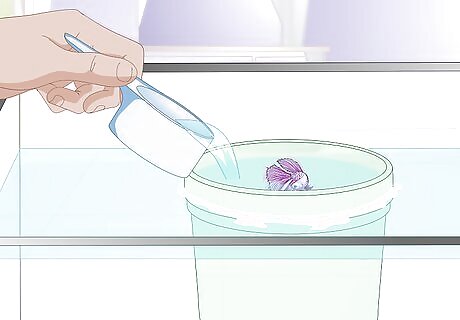
Add your betta. First, slowly and carefully add some of your tank water to the container in which you received your betta. Allowing the new water and old water to mix will make the water easier for your fish to adjust to––if the habitat water has different water chemistry than of its old container, mixing waters will help allay any shock for the fish. Float the cup in the tank to let the temperature adjust. Leave it like this for fifteen minutes. You may want to repeat the process to be safe. Then tip the cup into your aquarium, but try to add as little water as possible from the container to the new home, since sometimes water from the pet store can carry diseases and other things that you don't want in your tank. Be gentle as you tip in the betta! Avoid netting a betta if possible, as this can damage the delicate fins. If you need to pick up a betta, try to use a small cup to scoop him/her up with care.
Feeding the Betta
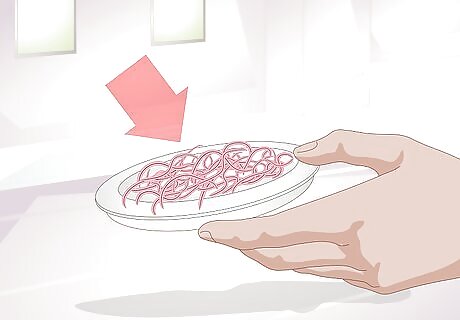
Pick the proper diet for your betta. Bettas are carnivores. Your betta's diet should consist of pellets specifically made for feeding betta, as well as a variety of other carnivorous foods. Frozen or live brine shrimp or blood worms are good options. Check the ingredients of betta specific pellets and flakes. The first three should be protein based. Experts say that protein in the pellets should be no less than 40%.
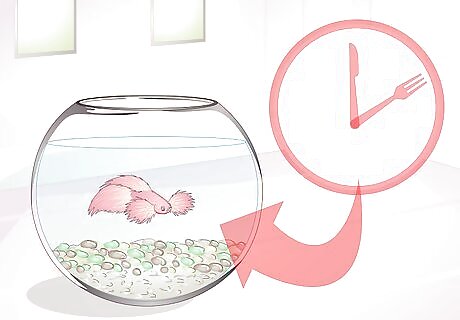
Feed your betta regularly. Betta fish vary in eating habits from each other, so experiment to see how much food your Betta eats. Set up routine feeding times, for example, once in the morning and once at night. If you stick to this routine, you may even find that your betta will be waiting for you when it's time to eat! Take care not to overfeed the fish. A betta's stomach is only about the size of their eye. Overfeeding can be a problem in some betta fish, as some fish will eat as long as you feed them (which can be fatal). A good feeding schedule is 3 pellets in the morning, and 3 at night. Soaking the pellets in water for a few minutes before feeding is recommended since the pellets will otherwise expand inside your betta's stomach, which can cause unhealthy bloating and digestive blockage. Overfeeding can cause bloating and bladder problems which can be fatal, although this is not as serious as a similar condition referred to as dropsy.
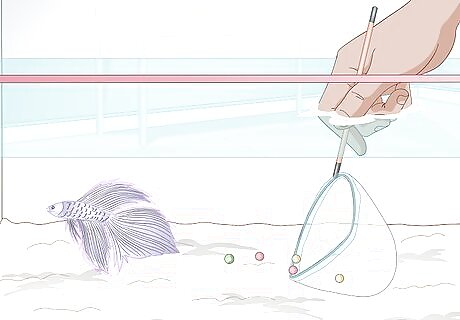
Clean up any extra food that your betta does not eat. Similarly, watch your betta to see if he/she spits up any food. This could be a sign that your betta is a picky eater, or it could also mean that the pellets are too big for the betta's mouth. Ironically, most big fish food companies don't realize that Betta fish have smaller mouths than, say, goldfish or others. You can cut the pellets in half with a small razor blade or such to allow it to fit in the betta's mouth easier. If it still refuses to eat, try another brand of pellets or dried food.
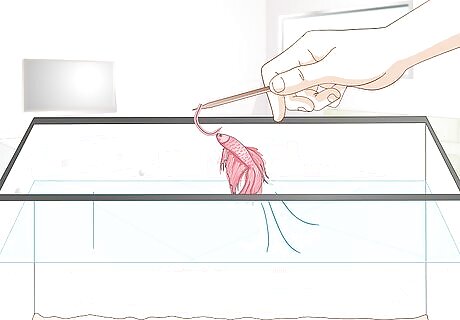
Turn feeding time into a little enrichment exercise. Put a straw in the tank and watch your betta to see if he/she gets used to it. If he/she does, and you have leftover betta food he/she won't eat, place one of the leftover pellets in the tank. Place the straw over it so that it is inside the straw. Hold the straw over the fish and wait for him/her to find it. After your betta finds it, he/she will follow it. You can then slowly lift the straw up to the top of the tank until the food pops out and your betta will eat it.
Keeping the Betta Tank Clean
Ensure your betta is properly acclimated. Betta fish are only hardy to a particular water type, such as a certain water hardness and pH. It takes them a while to acclimate to a new environment and this process is stressful for the betta. Allow your betta to fully acclimate before making any changes to their new home.

Clean your Betta's tank. Betta's thrive best in an already cycled tank with a filter, unless you are doing extremely frequent large water changes (but this can be stressful for the betta). Slow flow or sponge filters are recommended due to the betta's fragile fins. Vacuum the bottom of the filtered tank gently when doing routine small water changes. There are many symptoms of dirty water, such as fin rot. Not to worry, the problem is easily treatable. Be sure to always add a dechlorinator when adding new water. Be sure that the water you are changing is the same temperature as the old water the betta was in to avoid temperature shock. Use an in-tank thermometer to check the water temperatures.
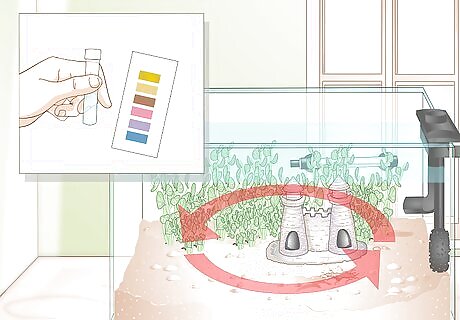
Test the water weekly. In order to test water parameters each week, you will need a master freshwater test kit. This will allow you to monitor your aquarium and take readings. Follow the instructions for testing provided by the manufacturer. Place notes in your calendar or diary to remind yourself that it's time to test and change the water.
Ongoing Enjoyment
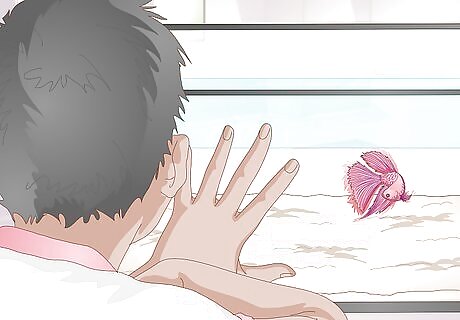
Have fun with your new friend. Betta fish come to recognize their owners. They will actually learn faces and even simple games. Keep your betta company and say "hi" once in a while, so he learns who you are! Betta fish are very curious and often develop a strong bond with their caretaker. They can "beg" for food by swimming up and down in the front of the tank when you come near.
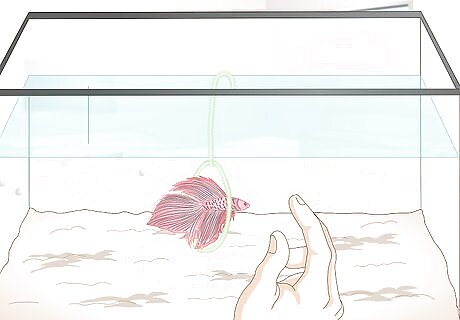
Play with your betta fish. Betta fish are enjoyable to watch and spend time with. You can play with your fish by moving your finger back and forth along the tank edge (never bang the tank or poke the water). Watch your betta follow you. And above all, don't forget to name your fish! Never tap the glass of the tank. This action easily agitates the fish and can cause the fish to go into shock. To interact through movement, simply slowly rest your finger on the glass and slide it along to see if your betta will follow it. If he/she backs away and seems frightened, then stop immediately. You can eventually try again once you the betta is more accustomed and less afraid of you. Avoid having a mirror as a permanent fixture in the tank, as it will make your betta believe there is another betta constantly in their territory and can cause stress. Using a mirror in moderation (once in a while for less than five minutes), however, can help a constipated betta defecate. Tank walls can sometimes be naturally mirrored as well, so consider purchasing underwater "wallpaper" to cover this up.




















Comments
0 comment